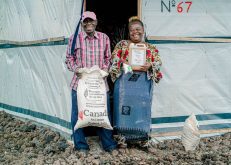Crops must be bred to resist insects and drought rather than relying heavily on pesticides and irrigation, Britain’s chief scientist said Oct. 6.
This will become increasingly important in order to counter the effects of climate change, John Beddington told Reuters.
“I think the role of genomics is enormous whether it is the GM (genetically modified) type or other genomic techniques which improve things. We need to do it,” he said.
Speaking after a conference here on food security, Beddington said demand for food was expected to grow by about 50 per cent by 2030 due to both a rising global population and changing diets in developing countries.
Read Also

Mazergroup’s Bob Mazer dies
Mazergroup’s Bob Mazer, who helped grow his family’s company into a string of farm equipment dealerships and the main dealer for New Holland machinery in Saskatchewan and Manitoba, died July 6 from cancer.
A needed expansion in production, however, would have to be achieved with less land, less water and less energy while not increasing emissions of greenhouse gases, he said.
“The green revolution 30, 40 years ago was built on much more fertilizer, much more pesticides, very extensive irrigation and seed improvements. Those were the major planks,” he said.
“I don’t believe we can solve our current problems in the way we did in the original revolution so we need a new and greener one. The new greener revolution is needing to be a tad more sophisticated,” Beddington added.
Pests and disease currently resulted in losses of about 40 per cent in certain crops, he said, and climate change would pose new threats “as some plants and indeed animal diseases are taking advantage of an altered climate to expand their range.”
Crop breeding had the potential to generate improved resistance to some of the key pests and diseases, he said.
Climate change could also reduce the amount of land suitable for agriculture and would mean care would have to be taken if land left fallow in areas of the former Soviet Union is brought back into active production.
“There is definitely extra land which could be put into agricultural production but the question is, what does that land look like? For example, if it is permanent grassland it has the potential to release greenhouse gases,” he said.
If meat and dairy prices were to rise then it could curtail demand growth, Beddington said. “To the extent that happens in the developed world that is probably OK. To the extent it happens in the developing world you’ve got real issues of malnutrition and hunger.”


















